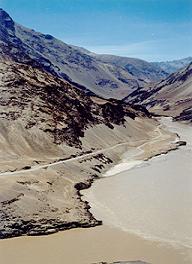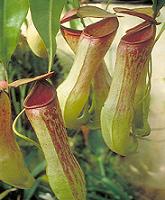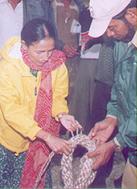Adventure
 'I believe any trip in search of wildlife can be coupled with physical activity and elements of cultural diversity to form a thrilling opportunity
' 'I believe any trip in search of wildlife can be coupled with physical activity and elements of cultural diversity to form a thrilling opportunity
'
John H.Eickert
The legend swirls in the hot dry air of Agra, describing the Taj Mahal as more than a tribute to a love. It perpetuates the legend of a place where civilization began, an Eden. A great
mountain in the middle of a raised plateau with four rivers flowing to the four compass points was the model for the Taj Mahal. The legend of such an Eden, a place of beginning, is reported from many cultures and religions. Does it exist? On the Tsangpo, plateau
of Tibet raises the holy mountain of Kailas, waters draining this large area flow to the four compass points. The Yellow river drains to the north, the Ganges to the south, the Brahmaputra to the east, and to the west drains the mighty Indus; the river we
overview this month, do you believe in legends?
 The Indus or "Lion River" stalks calmly into India from Tibet, roars east to Pakistan where it growls past Skardu and bends to the south barely missing the 8000-meter peak Nanga
Parbat. The Indus flows through the province of Ladakh. In the gentle sections above Leh, the river purrs past fields and gardens, great places to spot cranes and waterfowl. Nearing Leh the pace picks up and the power and voice of the river increase until
it nears the ocean far below in Pakistan. In Ladakh, the river is suitable for rafters of all abilities and types; most of the opportunities are day trips giving the adventurer a chance for a highly diverse itinerary. Sightseeing, monastery seeing and rafting
can all take place in one well-paced day. Be prepared for bright sun and strong winds. Two trips are worth the while of the day-tripper, Spituk to Sapol and Upshi to Khaltsi. Both trips offer white water thrills without intense objective dangers, very enjoyable.
The downside to these trips lies in their ease of access; easier access means more humanity means less wildlife, a mantra all too common around the world. Still, a day-trip out of Leh is a wonderful addition to a visit. Don't miss the Gompa at Hemis, the views
from the pass at Khardung and the fossil fields of Kalibangan. Remember, for an intense wildlife/rafting experience the previously discussed Zanskar rumbles out of the Himalayas nearby. There is much to see and do and experience here in this "Abode of the
Snow." Take your time and take the time! The Indus or "Lion River" stalks calmly into India from Tibet, roars east to Pakistan where it growls past Skardu and bends to the south barely missing the 8000-meter peak Nanga
Parbat. The Indus flows through the province of Ladakh. In the gentle sections above Leh, the river purrs past fields and gardens, great places to spot cranes and waterfowl. Nearing Leh the pace picks up and the power and voice of the river increase until
it nears the ocean far below in Pakistan. In Ladakh, the river is suitable for rafters of all abilities and types; most of the opportunities are day trips giving the adventurer a chance for a highly diverse itinerary. Sightseeing, monastery seeing and rafting
can all take place in one well-paced day. Be prepared for bright sun and strong winds. Two trips are worth the while of the day-tripper, Spituk to Sapol and Upshi to Khaltsi. Both trips offer white water thrills without intense objective dangers, very enjoyable.
The downside to these trips lies in their ease of access; easier access means more humanity means less wildlife, a mantra all too common around the world. Still, a day-trip out of Leh is a wonderful addition to a visit. Don't miss the Gompa at Hemis, the views
from the pass at Khardung and the fossil fields of Kalibangan. Remember, for an intense wildlife/rafting experience the previously discussed Zanskar rumbles out of the Himalayas nearby. There is much to see and do and experience here in this "Abode of the
Snow." Take your time and take the time!
Next month our primer will move away from the great rivers of India and on to other adventures. Indeed there are camels and elephants to be ridden (enough to give anyone a numb bum!),
jungles to be tramped through and mountains to be trekked, and there are many more rivers to be rafted, including the Tons! Also, there are an infinite number of day hikes scattered throughout India in each of her magnificent wildlife parks. There is so much
to do and see in this one incredible country. Is anyone making plans to go? Do you believe in legends?
Photograph: 'Indus' meets 'Zanskar' in Leh by Thomas Chacko
Contributed by
John H.Eickert
Num Bum Adventures
or call 406-777-2228.
|
Amazing Facts About Wildlife
By Prashant Mahajan
Insectivorous plants, also known as Carnivorous Plants, are interesting because of the wonderful methods they have adopted for catching their small animal prey. Although they trap insects and consume them, the prey never forms more than a very small fraction
of the food of these rare plants, all of which possess green leaves and obtain their main food supply in the normal way by photosynthesis. Why then do these plants trap insects? They are mostly found in swamps and bogs where there are few plants and animals.
This causes nitrogen deficiency in the soil. Insects and small aquatic animals have high protein content and so the insectivorous plants make up for deficiency of nitrogen, especially of protein, by digesting their prey. It is, however, quite possible for
them to live healthily without these animal-supplements to their food.
 Out of 450 species of carnivorous plants in the world, about 40 species are found in the Indian subcontinent. These are classified as Sundew, Butterwort, Venus' Fly-trap, water Fly-trap, Pitcher Plant and Bladderwort. Out of 450 species of carnivorous plants in the world, about 40 species are found in the Indian subcontinent. These are classified as Sundew, Butterwort, Venus' Fly-trap, water Fly-trap, Pitcher Plant and Bladderwort.
Sundew is a small herb whose leaves are covered with numerous glandular tentacles, secrete a viscous fluid which glitters in the sun like dew drop. When the insect mistaking the glistening substance for honey alights on the leaf, it gets entangled. Like
Sundew, Venus'Fly-trap catches insects with its leaves. Water Fly-trap (Aldrovanda vesciculosa) is a widely distributed plant which is found in salt-lakes of the Sunderbans, Freshwater jheels of Bangladesh and in ponds of Manipur. Pitcher Plants are the most
remarkable of the insectivorous plants, which are found in tropics, especially in Asia.
One species, Nepenthes Khasiana, is found only in India in Khasi, Jaintia and Garo Hills. The pitcher vary from 10 to 20 cm in height and are brightly coloured. When young the mouth of the pitcher remains closed by a lid, which afterward opens and stands
more or less erect, thus leaving mouth open. The plant exudes sweet substance, which act as a bait for the insects. The insect attracted by the bright colour and sweet exudation, crawls up to the mouth and tries to get the sweet material present inside. In
doing so it slips inside and tumbles down through smooth and sharp hairs pointing downwards. The struggling insect is thus trapped, becomes tired out after a while, falls down into the liquid and is finally drowned. The liquid contains protein-digesting enzymes.
The insect is digested and ultimately the nitrogenous food absorbed.
Due to deforestation and over collection of insectivorous plants by botanists most of the plants are on the 'Endangered List' of Indian Flora.
(Source: Encyclopedia of Indian Natural History by R.E. Hawkins)
|
Answers To Quiz Of The Month
Last month no one has given all right answers, but this time san_e@rediffmail.com,psen75@yahoo.com and ritix@rediffmail.com have given 7 right answers
Right Answers to 'Elephants Quiz Part IV'
1. The weight of a baby elephant at birth is …...
□ 50 kg
□ 90 kg □ 40 kg
2. How much water can an elephant drink in a day?
□ 500-800 litres □ 300-500 litres
□ 100-300 litres
3. What are the 'annulus'?.
□ rings on the trunk
□ toenails □ hair on the tail
4. If an elephant dies of old age, how does it die?
□ its last set of teeth falls out & it starves
□ its heart bursts □ in a fight with a younger member
5.How fast is an elephant's sprint?
□ 15 mph
□ 25 mph □ it can't sprint
6. When does an elephant reach maturity?
□ 18 years
□ 25 years. □ 12 years
7. Elephas maximus is the term used for….
□ Asian Elephants □ African elephants
□ Asian & African elephants
8. In what year did Hannibal ( of Carthage, invading Italy) use elephants when he crossed the Alps?
□ 1100 A.D □ 218 A.D
□ 218 B.C
9. In 1882 P.T. Barnum purchased 'Jumbo' and made hima star of his circus. Jumbo was an elephant from ….
□ India □ Thailand
□ Africa
10. There are two types of African Elephants. One is the Forest elephant. What is the other one?
□ Savannah elephants
□ Bush elephants □ Desert elephants
Your are in the age group:
□ Below 18 years □ Between 19 & 30 □ Between 31 & 50 □ Above 50 years
Please try our quiz for the current month at
Large Mammals
|
Bird Watching
Recently a bird watching trip was organised by Dr.Susan Sharma of IndianWildlifeClub.com. Armed with binoculars & books on birds, on a cold wintry Sunday morning we reached Okhla barrage along with Mr Mahendra Vyas, who is an eminent environment lawyer as
well as bird expert. We met up with few other members of the club. Although we had gone to see many migratory birds we were able to spot a wide variety of indigenous birds, in fact a total of 21 species. We spotted Herons standing majestically on small vegetation
islands waiting for their prey. The Purple & Grey Herons looked similar but a small patch of white on the Purple Heron was more distinct from its counterpart. The flocks of
Coots as well as Dabchicks, Gulls, Teals
& Cormorants were more visible. The Dabchicks (small ducks in layman's language) were more naughty than others. They all suddenly dipped underwater one by one & appeared some 4 or 5 feet away. Their antics kept us guessing as
to which was which. Two members of our group spotted a pair of Bronze headed Jacana, which is a shy bird.
A marshy area near the river was also abundant with lots of birds. A Crow Pheasant (Lesser Coucal), size of a hen, with brown feathering and a long tail was picking up small insects & making loud sound of 'Hoo - Hoo'. A
Bronze Drongo sitting on the branch with shiny feathers & a fork tail,
common Kingfisher also sitting near the bank hunting for a fish,
Pied Mynah, Hoopoe ( whom we casually call a wood pecker ),
Tailor bird, Long tailed Shrike (formerly known as the Rufus headed shrike),
Jungle babbler & Warbler (the common garden variety) were also amongst those we spotted.
 Moving further on, we met another large group of bird watchers who were members of the Delhi Bird Group. Our group had the advantage of having Mr. Mahendra Vyas who took pains to personally identify and point out the birds to us. On reaching the Okhla
bridge on our return journey, we spotted an Avocet, whose beak was very peculiar. It was long, thin & slightly upturned at the end. Also there was the
Black winged stilt, Sandpiper & Red Shank. Moving further on, we met another large group of bird watchers who were members of the Delhi Bird Group. Our group had the advantage of having Mr. Mahendra Vyas who took pains to personally identify and point out the birds to us. On reaching the Okhla
bridge on our return journey, we spotted an Avocet, whose beak was very peculiar. It was long, thin & slightly upturned at the end. Also there was the
Black winged stilt, Sandpiper & Red Shank.
Thus, we ended our sojourn of bird watching & returned home but those hours were well spent as we not only learned about birds but also enjoyed witnessing them in their natural environment.
- SHIVANI THAKUR
( Photograph of the Avocet is from the book 'A photographic guide to Birds of India and Nepal' by Bikram Grewal)
|
Endangered
What is India doing to protect the Asian elephant?
Assam is home to more than half of India's 10,000 elephants. It has the world's largest concentration of Asiatic elephants.
To increase awareness about wildlife and reduce "tension between elephants and man", Assam celebrated a two-day elephant festival from January 12-13, at Mihimukh near Kaziranga National Park.
 The decision to celebrate such a festival was taken after growing attacks on elephants and the death of five elephants in the state's Sonitpur district in October last year. The decision to celebrate such a festival was taken after growing attacks on elephants and the death of five elephants in the state's Sonitpur district in October last year.
They were killed by farmers whose standing crops and property were destroyed by the rampaging elephants.
The U.S. Fish and Wildlife Service, a leading organization of the United States has decided to sanction $30,000 for conservation of elephants of the State. The funds have been sanctioned for the two project - Kaziranga National Park and Digboi area. The
organization has been extending financial assistance for conservation of wildlife which are facing extinction due to depletion of forest cover.
The state government announced an award of U.S.$200 ( Rs 10,000) for information that could be helpful in saving elephants from being poisoned or that could lead to the arrest of persons guilty of killing them.
Disturbances created in the natural habitat of elephants at Jharkhand and Orissa by encroachment, cutting of trees, and other human activities prompted these wild elephants to migrate to Chhattisgarh. Rogue elephants claimed 30 lives here.
Chhattisgarh government's 'Operation Tuskers', launched under Parbati Barua aims to secure the state's borders against the menace of wild elephants coming in from outside its borders. Parbati Barua, has already caught one wild male elephant with the help
of tranquilizer guns and Barua's two trained elephants ( koonkies). The plan is to catch and train four wild elephants and drive away the rest to their original habitat. ( Photograph shows Parbati Barua teaching a mahout how to use the rope noose to catch
the wild tusker. )
Are captive elephants also "Wild"?
The elephant is genetically designed to be naturally wild even after domestication . A domesticated elephant may appear to be tame, but instinctive compulsions will inevitably drive it to exhibit its inherent wild side often passively and occasionally in
a more violent manner.
According to S.S. Bist, director of Project Elephant, India, there is a tendency to dismiss the domesticated elephants as another category of cattle and this could be the reason why domesticated elephants have not received due attention from conservationists
despite the fact that are also classified under schedule-1 of the Wildlife Protection Act. In fact, under the Act, domestication has been permitted in the overall conservation interests of the species, he said. Alarmed by the frequent instances of elephants
running amok and goring mahouts to death, the Kerala government proposed to shortly come out with a set of rules on management and upkeep of captive elephants which will include penal provisions to check maltreatment of the animal.
The rules would be made under the Wildlife (Protection) Act, which currently applied to wild animals only, but a section of the Act would be extended to captive elephants also, he said.
The rules will specify norms to be followed when elephants are paraded during festivals, transported by foot or by vehicles, medical check-up and provision of water,fodder and accommodation and training of mahouts. It will also lay down how to handle them
at times of 'musth', when domestic pachyderms often turn violent.
The rules would prohibit elephants being made to walk more than three hours or 30 km at a stretch. Those taking them for long treks would have to carry reflectors during night in the front and rear of the animal for road safety. Keeping elephants without
being fed sufficiently would be made an offense.
|
Endangered
By Dr. Susan Sharma
 Schedule I, Part III of the Indian Wildlife (Protection) Act, 1972 lists rare and endangered birds which are totally protected throughout the country, live or dead or part thereof. They include Andaman Teal, Assam Bamboo Partridge,
Bazas, Bengal Florican, Blacknecked Crane, Blood Pheasants, , Eastern White Stork, Forest spotted owlet, Jerdon's Courser, Cheer Pheasant, Great Pied Hornbill, Hawks, Hooded Crane, Hornbills, Houbara Bustard, Humes Bartailed Pheasant, Indian Pied Hornbill,
Lammergeier, Large Falcons, Large Whistling Teal, Monal pheasant, Mountain Quail, Narcondam Hornbill, Nicobar Megapode, Nicobar Pigeon, Osprey, Peacock-Pheasant, Peafowl or Indian Peafowl, Pinkheaded Duck, Scalter's Monal Pheasant, Siberian White Crane, Tibetan
Snowcock, Tragopan-Pheasant, Whitebellied Sea Eagle, White-eared Pheasant, White Spoonbill, and Whitewinged Wood Duck. Schedule I, Part III of the Indian Wildlife (Protection) Act, 1972 lists rare and endangered birds which are totally protected throughout the country, live or dead or part thereof. They include Andaman Teal, Assam Bamboo Partridge,
Bazas, Bengal Florican, Blacknecked Crane, Blood Pheasants, , Eastern White Stork, Forest spotted owlet, Jerdon's Courser, Cheer Pheasant, Great Pied Hornbill, Hawks, Hooded Crane, Hornbills, Houbara Bustard, Humes Bartailed Pheasant, Indian Pied Hornbill,
Lammergeier, Large Falcons, Large Whistling Teal, Monal pheasant, Mountain Quail, Narcondam Hornbill, Nicobar Megapode, Nicobar Pigeon, Osprey, Peacock-Pheasant, Peafowl or Indian Peafowl, Pinkheaded Duck, Scalter's Monal Pheasant, Siberian White Crane, Tibetan
Snowcock, Tragopan-Pheasant, Whitebellied Sea Eagle, White-eared Pheasant, White Spoonbill, and Whitewinged Wood Duck.
The Great Indian Bustard is a a big, shy bird, resembling the ostrich. Though a good flier, it prefers to walk. It loves open spaces; it even roosts and breeds in the open. Formerly it was widely distributed in the grassy plains
of India. Now it is confined to a few pockets in Rajasthan, Gujarat, Madhya Pradesh, Maharastra, Andhra Pradesh and Karnataka states of India.
The Bombay Natural History Society, which has conducted extensive studies on the three Indian bustard species - namely the great Indian, the lesser florican and the Bengal florican - has estimated that the total population of
the great Indian bustard in all 12 sanctuaries in the country is only about 1,000.
 The biggest of these sanctuaries is the Desert National Park in Rajasthan which has about 100 birds. This bird has been included in the Schedule-1 of Wildlife Act 1972 and accordingly due protection has been given to this
bird. The main causes for reduction in their numbers are, habitat destruction and habitat deterioration, overgrazing by too many domestic animals, disturbance during breeding and conversion of grasslands and so-called wastelands into crop fields. The biggest of these sanctuaries is the Desert National Park in Rajasthan which has about 100 birds. This bird has been included in the Schedule-1 of Wildlife Act 1972 and accordingly due protection has been given to this
bird. The main causes for reduction in their numbers are, habitat destruction and habitat deterioration, overgrazing by too many domestic animals, disturbance during breeding and conversion of grasslands and so-called wastelands into crop fields.
The sanctuary approach certainly helps in curtailing poaching but unless appropriate habitat protection measures are taken, declaring a sanctuary for bustard does not help in the long run.
Table: Present situation in Bustard sanctuaries ( Figs as per BNHS study)
| Name of Area
|
Bustards in 1985 |
Bustards 2001
|
| Karera Sanctuary,MP |
25-30 |
Extinct |
| Ghatigaon Sanctuary,MP |
15-18 |
2-3 |
| Rannibennur Sanctuary, Karnataka |
2-3 |
2-3 |
| Nannaj, Maharashtra |
15-25 |
30-40 |
| Sorsan,Rajasthan |
10-15 |
Extinct? |
| Sonkhaliya,Rajasthan |
80+ |
30-35 |
| Desert National Park Rajasthan |
200-400 |
50-100 |
| Rollapadu,AP |
60+ |
15-20 |
| Lala and Naliya grasslands, Kutch |
|
25-30 |
| Near Nasik, Maharashtra |
|
8-10 |
| Nasik-Aurangabad border |
|
20-25 |
Beside, the Great Indian Bustard is still found in many parts of the Thar desert, especially in Jaisalmer, Jodhpur, Barmer and Bikaner district but in most areas, it is declining due to various reasons. Perhaps the total bustard
number in the Thar desert is less than 500.
( Photograph of the female bustard by Dr. Asad Rahmani , BNHS, Mumbai)
|
News and Views
 Our elephant story writing contest is drawing to a close this month. ( 28th February is the last date for submitting your entries online.) So please hurry up and send in your entries fast! We have already received some touching snippets of conversation
between the elephants. These intelligent and gentle creatures inspire all of us who love wildlife! Our elephant story writing contest is drawing to a close this month. ( 28th February is the last date for submitting your entries online.) So please hurry up and send in your entries fast! We have already received some touching snippets of conversation
between the elephants. These intelligent and gentle creatures inspire all of us who love wildlife!
We have started a web product store this month. To start with there are only two products in the store and they are for sale inside India only. See WILDSCAPES product store byclicking here.
We hope to roll out our other products soon with sales both within and outside India.
Here is how you can help us raise some funds for continuing our activities
If you are a tour organizer or know a tour organizer
- Who arranges trips to nature as an environmental adventure
- Offers site sensitive accommodation by minimizing visitor impacts on the environment and local culture
- Offers itineraries and promotions to avoid overselling popular sites
Then you or your friend may want to appear on our eco tourism page
Click here for an irresistible offer
The Delhi chapter of Indian Wildlife Club organized a bird watching outing at Okhla barrage. 2nd February 2003, Delhi was just coming out of intensely foggy days. Those of us who went did find the trip worthwhile though. Read all about it elsewhere in the
ezine.
We had a lively chat on the 'Asian Elephant' on 18th February 2003. The chat was moderated by Mr. M.K.S Pasha, Director, Wildlife Protection Society of
India. Read the chat transcript on the homepage.
…….and Views
"Listen to the sounds of nature. Take care of our fragile planet."
|
Poem
(Dedicated to the jungle of Pench)
Ambling down, a moonlit town
at zero in the night
people asleep, in slumber so deep
ignoring all those beautiful sights
In jungle deep a placid lake
scatters the silver of a rising moon
 crickets in reeds singing merrily crickets in reeds singing merrily
in somniferous tunes
Hiding itself in brown and grey
a carnivore lurks to catch its prey
intermittent calls of the jungle pals
alarming others-Beware! don't fall
life stands still, the air gets filled
with an engrossing thrill
and a lonesome man, ambles down
the Jungle deep
Suhas Kumar
Copyright ©2003 Suhas Kumar
( Photograph of forest scene by Jayant Deshpande)
|